You want to make sure all online business interactions are secure. Email is one of the most common ways that employees communicate with colleagues and individuals who work outside of their organization. The information you put in emails is likely confidential, at least to some extent, and definitely isn’t something you want just anyone reading. Especially for businesses, you don’t want any data sent via email to be accessible by an unauthorized user. Having a secure email server is critical to maximize business privacy and ensure that all emails are sent/received safely and securely. Google Workspace is a great business tool and the perfect option for a secure email server.
How Your Email Gets From Here to There
You can send an email just by clicking “send.” Seems easy, right? Well there are a lot of steps involved in getting an electronic message from point A to point B. The email must travel through a network of email servers before reaching its final destination. How does that happen? That’s controlled by your email server, which is designed to receive, process, and forward emails. There are two types of email servers: incoming and outgoing mail servers, each handling either mail that is sent to you or mail that you send to another recipient
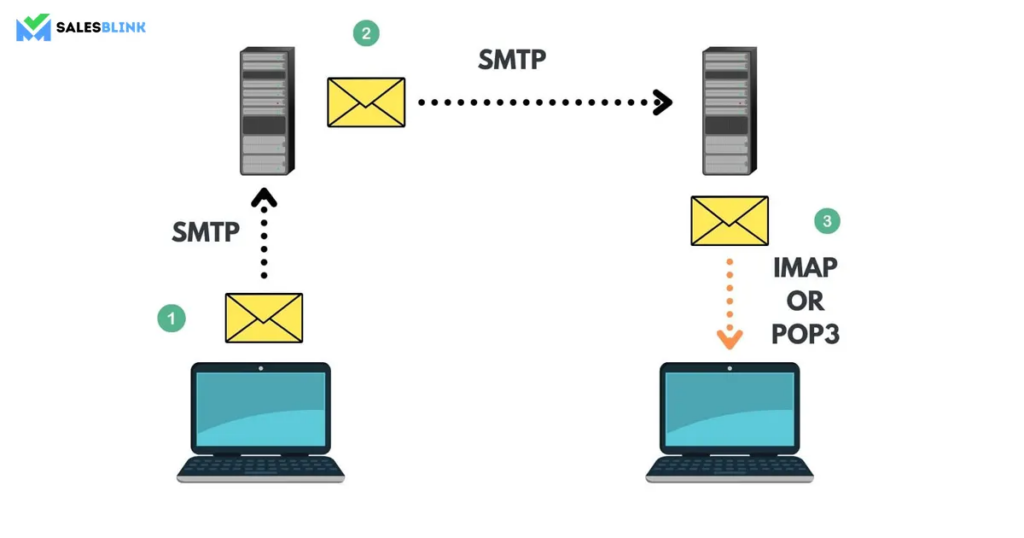
With any form of technology, transmitting information over a network/server can run the risk of interception. This means that a hacker or unauthorized person can access information within an email if there isn’t good security. Email, like SMS and phone call, is a great way to communicate, but might not always be entirely secure.
Email Is Great for Communication, but Comes With Some Unwanted Risks
• Business Email Compromise (BEC)
BEC (business email compromise) is one of the most damaging cybercrimes, in which hackers try to target businesses into performing an illegitimate transfer of funds. It incorporates social engineering tactics to trick recipients.
• Phishing
Phishing is a social engineering scam that commonly makes its way to employees via email. It involves a link made to look like something other than what it is. Users think the link will go one place but it leads to another. Without the cyber security awareness training to protect against phishing, these malicious emails can be very harmful to a business.
• Malware and Ransomware
Two major cyberthreats are ransomware and malware, which can be spread via email. These attacks, especially ransomware (which is often the cause of countless data breaches), can be unbelievably costly for businesses.
• Spam Messages
Spam emails are surely quite annoying to scroll through and delete. They can also unfortunately pose risks by including fake, malicious links.
• Data Leak Potentiality
Without the right security and privacy measures in place (ex. encryption), there’s a possibility that data sent through email can get leaked. This puts confidential information at a high risk.
Secure Email Server: Communicating With Advanced Security
A server is a system that provides data and acts as a communication network for other devices/programs known as clients. Your typical email server works just like a server but specifically for emails; it acts as a layer that emails pass through before reaching the recipient. Secure email servers use advanced security protocols to further protect messages. This keeps your business safe against those risks we mentioned, maximizing protection for your organization.
1. Strong End-to-End Encryption (E2EE)
Encrypting emails ensures that the data sent in emails is only understandable for the sender and the receiver. This way, no one can intercept the message and possibly jeopardize the content. Encryption is a way of scrambling data, so that only authorized users can access the information. Basically, plaintext, which is readable to humans, is translated into “ciphertext,” which is incomprehensible code. To read the data in plaintext, the text must be decoded with an encryption key. When encrypted, hackers can’t easily access the information in an email, making these messages much more secure than an unencrypted email.
2. Authentication to Access Email Services
To access your email, you’re going to want to have some sort of two-step (2fa) or multi-factor authentication (MFA) to verify that it’s really you. A secure email server offers this, which ensures that you’re actually the user trying to access your email.
3. Spam Protection and Prevention
Secure email servers use machine learning and artificial intelligence (ML/AI) to keep spam messages out of your inbox. For example, Google Mail has its own separate “Spam” folder, which contains all of the spam messages you receive.
4. Virus Protection
A secure email server includes antivirus protection. Many senders try to attack recipients via email using malicious links and attachments that might spread viruses or deploy malware and/or ransomware. These threats can be damaging to an organization, so virus protection is an essential component to protect your business.
5. Proactive Anti-Phishing Protocols
A secure email server will have the right proactive measures to protect users against phishing attacks.
The Problems With Having Your Own Email Server
Many businesses and organizations choose to set up their own secure email server. This might seem like a good idea but it’s actually a complicated process that isn’t really necessary to go through. The time and effort it takes to set up an email server is simply not worth it. Plus, it can involve a bunch of problems that could easily be avoided by simply using a well-established secure email server.
💸 Costly Hardware and Software
Creating a private secure email server can be costly, especially when considering the server hardware and software that goes into setting one of these up. That would include installation and management of an additional server, beyond equipment that you might already have. The tedious process involved, along with the extra added expenses, clearly indicate why an external email server would be a better option.
🛠️ Needs Constant Maintenance
Running your own server is going to take a lot of time and effort. The ongoing responsibility can be an unnecessary hassle for small and medium sized businesses. Keeping a server up-to-date with the right software and hardware might be exorbitant and laborious. You are accountable for maintaining security, which is a huge job, especially for smaller businesses with less of a budget or no dedicated staff.
🔌 Might Be Unreliable
When you’re hosting your own email server, there’s no guarantee that everything will go through. Some emails might not be sent or received if there’s a bug in the server, so it might not be the superior option. Servers like Google and Microsoft have technology infrastructure worth millions of dollars, so naturally, they’ll probably be the more reliable option. Having a private email setup also won’t include the same support and technology that you need for sending and receiving emails. If the power goes out or technical issues arise, you might run the risk of not being able to send or receive emails at all, which means you’ll miss out on important messages.
🦟 Easily Hacked
Going back to the need for constant maintenance, keeping these servers up-to-date is difficult. When you don’t, you run a greater risk of cyberattacks, like ransomware, malware, viruses, and more. Don’t let the word “secure” fool you. Just because you set up a “secure” email server doesn’t mean it’s any less vulnerable to hacking. In fact, these servers are quite the target for cyber attackers. That means a greater risk for things like ransomware and malware.

Google Workspace as Your Secure Email Service Provider
Using Google Workspace for your business can help with efficiency, communication, collaboration, and organization. Workspace comes with advanced security for your Gmail (email) account. This makes it a fantastic secure email server option for businesses. Make note that, depending on your Google Workspace subscription, the use of some features might differ.*
Encryption
Gmail, as well as most other major email providers, already try to send messages with Transport Layer Security (TLS), which is a basic form of encryption. If both the sender and recipient use an email provider that supports TLS, your emails will be encrypted. However, if either the sender or recipient doesn’t use a mail provider that supports TLS, then the emails will not be encrypted. We’ll explain more of the intricacies of TLS shortly.
TLS is not an end-all, be-all security marker. With Google Workspace, you can also enable S/MIME encryption, which is a widely accepted internet protocol that can be used to send encrypted messages.
Secure/Multipurpose Internet Mail Extensions (S/MIME) encrypts emails with user-specific keys to protect messages during transmission and delivery. S/MIME only works when both the sender and receiver enable it. Communication from one Google Workspace account to another, for example, can be encrypted with S/MIME. Encrypting emails is easy and a standard part of Google Workspace, making it a great secure email server.
Emails are not automatically encrypted and users have to turn on this feature to make sure that messages are sent securely. Because of the nature of servers, hackers are able to compromise data (your emails) while they are being sent. Without encryption, the email is readable as plaintext to anyone that accesses them in transport. We can compare encryption to traveling with luggage. Say you travel to another state or country on a plane and check your suitcase. Once it is out of your hands, anyone can open up that suitcase. Until you get your suitcase back into your own hands, its contents are accessible by anyone. Of course, there is protection from the airline and travel agencies as the suitcase is being transported. But hypothetically, if placed in the wrong hands, that suitcase could easily be “hacked.” However, if you put a lock on it (“encrypt” it), no one else can access the items in that suitcase without a key. Encrypting emails is similar – no one can see the contents of an encrypted email without an encryption key, so the messages are safe before, during, and after transportation.
Authentication
When accessing your Google Workspace account, it’s best to do so while utilizing two-factor authentication (2FA), as it’ll make your email far more secure. This can be done with a security key, a mobile app like Google Authenticator or other authentication methods as well; however we’d like to emphasize that security keys are the most secure form of 2FA available. For Google Workspace Business accounts that’s great news, since they support the use of security keys, which will greatly fortify security.
Spam Filtration
Google Workspace does the work for you to keep those spam messages out of your main inbox. This way, employees can avoid those annoying spammy messages and move onto the important stuff.



Security Options for Your Google Email
List of Advanced Gmail security options, from Google Workspace Admin Help
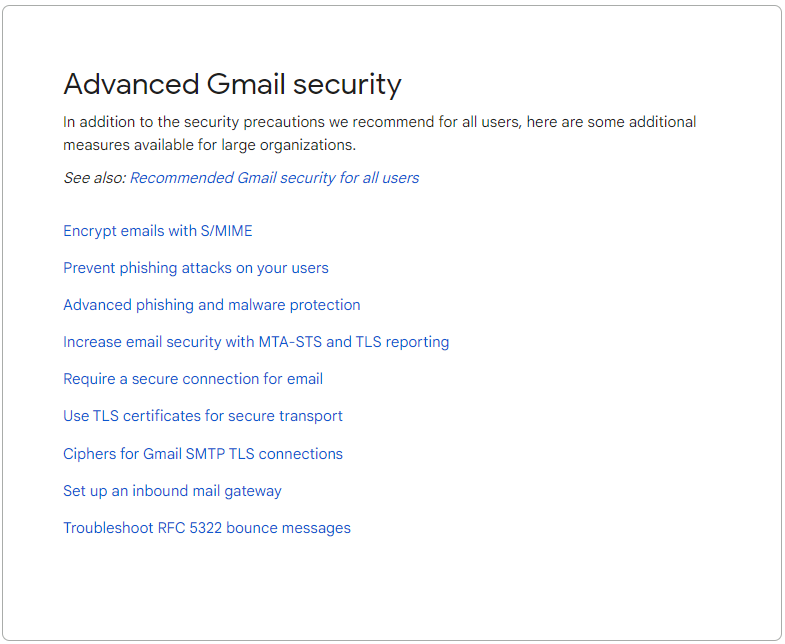
S/MIME Encryption
As seen in the screenshot example above, Google Workspace can add that extra security layer to your emails with S/MIME encryption. They provide options to require S/MIME for outgoing messages as well, which means that no one in your domain will be able to send out an email unless the recipient also uses S/MIME encryption.
Require TLS for Emails
Google Workspace has an option that requires a secure connection for email. While Gmail tries to send most messages with TLS connection, they will still send the message even if the recipient doesn’t have TLS. In that case, the connection might not be secure, creating a potential vulnerability for the sender. Google Workspace allows administrators to add TLS compliance to always use TLS for emails sent to the domains and addresses that you specify.
Advanced Phishing and Malware Protection
Organization administrators can protect employees from phishing emails and malware. You can also choose what to do with these suspicious emails, filtering them right into spam or flagging them with a warning tag, for example.
Advanced Security Settings
Google Workspace allows the administrator to have access to some advanced security features to better secure your email. This includes attachment protection, suspicious email link protection, external image protection, and spoofing/authentication protection.
Increased Email Security with MTA-STS and TLS Reporting
With Google Workspace’s secure email, your business can turn on MTA Strict Transport Security (MTA-STS) for your domain to increase Gmail security. MTA-STS requires authentication checks and encryption for emails to be sent to your domain, so your organization is better protected from outside senders that might be targeting your business. Here’s what Google has to say about MTA-STS email security:
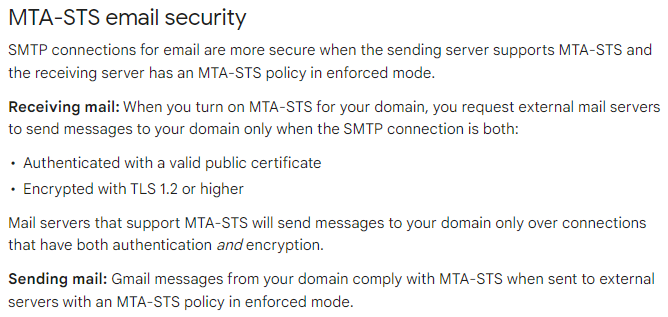
From Google Workspace Admin Help: About MTA- STS and TLS Reporting, learn more about how to configure those settings on Google’s Admin Help website
Setting Up Email Authentication Methods
With Google Workspace as your secure email server, you can set up certain authentication methods for your domain. Google recommends:
- SPF (Sender Policy Framework) which makes it harder for fraudulent senders to send spoofed information
- DKIM (DomainKeys Identified Mail) uses a digital signature to tell the recipient that the message was sent and authorized by the domain owner
- DMARC – an acronym for Domain-Based Message Authentication, Reporting, & Conformance – enforces SPF and DKIM authentication

What Else Can Google Workspace Do For Your Business?
As mentioned, Google Workspace has a lot of advanced features for its email services, as well as other software and products included in the package. This includes: Drive, Docs, Sheets, Calendar, and Chat/Spaces. This collection of Workspace tools can increase business productivity and efficiency when used to their full potential. Learn more about how your business can incorporate these features with Computero’s Google Workspace Help Zone.
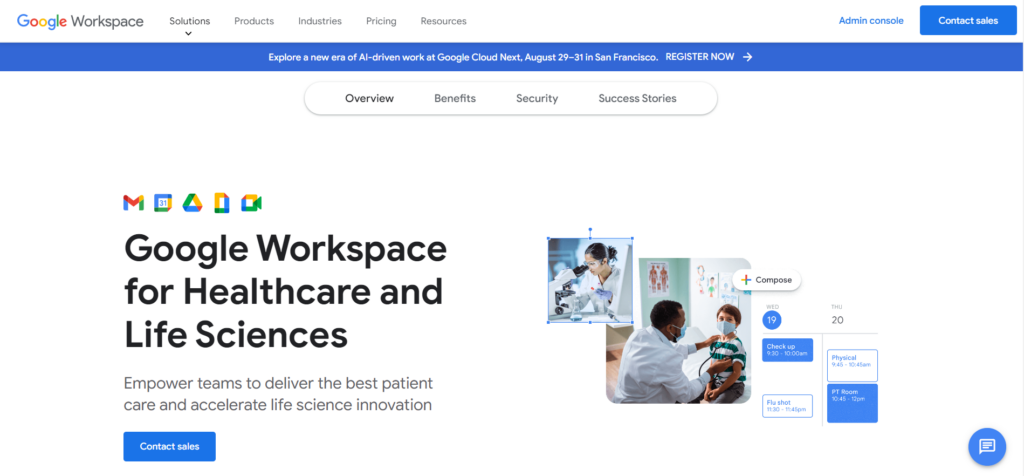
Google Workspace Is Suitable for Small and Medium Sized Businesses of All Types
Google Workspace is a must have for all businesses, no matter the size or industry. From financial and accounting firms to health, law, manufacturing, and more, Google Workspace is the perfect option for a secure email server for just about everyone. The workspace acts as more than just your email provider with built-in solutions for communication, security, collaboration, and more. In fact, Google Workspace can be used to your advantage to help you optimize your business operations. For instance, Google Workspace for Healthcare and Life Sciences can provide many solutions when it comes to cost savings, advanced cybersecurity, HIPAA compliance*, hybrid work, and improved patient care.
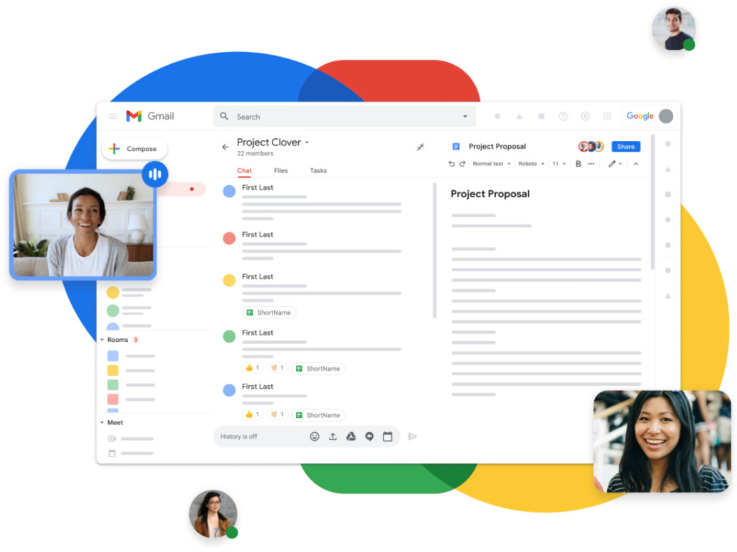





0 Comments